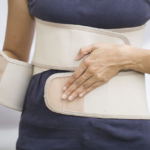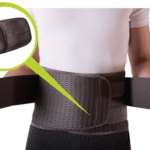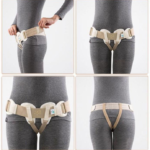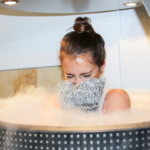The use of a belt for intervertebral hernia
With a hernia of the spine, the diseased part of the back needs additional support and unloading, which can be provided by wearing a special belt. A therapeutic bandage is prescribed for patients with pathology of the spinal column, when the condition requires it. Indications are usually pain, muscle weakness, the need to perform physical work, the risk of accidental injury and complications.
The belt for the spine with a hernia is selected by the doctor, taking into account the degree of the disease, the localization of the pathological focus and the general condition of the patient.
There is a cervical corset, a belt for the thoracic and lumbar regions. Treatment of a herniated disc is a long and complicated process, but long-term wearing of a brace is dangerous, because it is prescribed at certain periods when certain risks are present. A mandatory indication for the use of a corset will be the postoperative period.
Appointment of a corset for disc herniation
A corset with a hernia of the spine performs several functions at the same time:
- reduces the load on the diseased spine;
- stretches the spinal column;
- corrects posture;
- evenly distributes pressure on the intervertebral discs;
- eliminates muscle tension;
- reduces the severity of pain syndrome;
- prevents infringement of a hernia and compression of the nerve roots;
- ensures the correct position of the back.
A corset for the back with a hernia can be used for complete immobilization due to rigid fixation. There are also soft belts that have a warming effect, promoting normal blood flow. They are most often prescribed for the pathology of the intervertebral disc in the thoracic and lumbar regions.
It is possible to wear a corset with a hernia both for therapeutic and prophylactic purposes.
The protrusion of the thoracic disc is often combined with a curvature of the spine, and then a special bandage will have several positive effects at the same time. A corset for the spine with a hernia of the cervical region is prescribed for complete immobilization, because this is the most mobile part of the spine, and careless movement or increased load will lead to complications. The support bandage helps to increase the space between the vertebrae, which eliminates the compression of the diseased disc, thereby reducing pressure on the surrounding soft tissues, especially the spinal roots.
Types of corsets for hernia
Orthopedic devices for the spine with a hernia are created taking into account the characteristics of the pathology in people of different age groups and physique.
Classification according to the degree of rigidity:
- Soft . Indicated for disc herniation in the lumbar, thoracic and cervical regions. They are made mainly from camel or dog hair. Their main purpose is to reduce the load on the affected area of the spine. They have a massage effect, warm the back, contributing to the normal flow of blood.
- Semi-rigid . Indicated after surgery and in case of risk of complications. They relieve muscle tension, warm tissues, limit the movement of the vertebrae.
- Hard . Indicated for patients with severe disease. Such belts have metal ribs that securely fix the diseased section. Corset with rigid inserts completely restricts movement, relieving stress from the muscles. They are used more often after surgery, and are prescribed exclusively by the attending physician.
The benefits of using corsets can only be assessed after several months of regular wear. Long expectations of the result affect the opinion of patients about the use of orthopedic devices. Many attribute them to useless measures, and refuse to apply for various reasons.
Surgeons and rehabilitologists are ambivalent about corsets. On the one hand, this is a great way to prevent complications by relieving the burden on the patient department. But on the other hand, such an adaptation aggravates the disease by causing muscle weakness that ceases to perform its function.
Corsets for the lumbosacral spine are fixed at the waist with Velcro or clasps. The belt captures the lumbar and sacral regions, as well as part of the chest. In some models, locks are built in, so it can be partially unfastened without removing it.
With a hernia, a semi-rigid belt with solid inserts is more often prescribed. It is recommended to wear it during physical work and when playing sports. It is well suited for displacement of the vertebrae and for the prevention of infringement of the nerve roots.
Treatment of a hernia of the cervical spine is carried out using a special splint. A corset for the neck must be worn constantly, leaving it overnight. After the operation, the neck corset is prescribed for several weeks. Children need to wear such a tire with torticollis, because then there is a risk of damage to the intervertebral discs. Other indications for wearing it will be curvature and deformation of the spinal column, past injuries of the cervical region, and muscle damage.
A corset for the neck has many contraindications, therefore it is strictly forbidden to make a decision on its use on your own.
The belt for the thoracic region resembles a vest that wraps around the thoracic and lumbar regions of the back at the same time. With a hernia, the doctor prescribes a semi-rigid corset with several plastic or metal ribs. Severe pathology with a risk of infringement will be an indication for the use of a corset that covers the entire spine.
With concomitant scoliosis, a reclinator in the form of an elastic band in the shape of a figure eight would be a good option. It prevents the displacement of the vertebrae and ensures the normal anatomical position of the spine.
Choosing a brace for the spine
Therapeutic corset for the prevention of a herniated disc is selected together with the doctor, who assessed the X-ray images in detail and collected the patient's life history. Considering that it is impossible to get rid of a hernia without surgery, the bandage will be a preventive measure, and only for a short time. It must be worn daily during physical work. In different periods of the disease there will be a different schedule for wearing the belt, and any change in condition may be a reason to change the treatment regimen.
When the state of health worsens, you should check with the doctor whether it is possible to use the bandage in the usual way or whether it should be abandoned.
Rules for choosing a belt for a hernia of the spine:
- the bandage should fit closely to the body, but not squeeze it;
- before buying, it is necessary to try on the belt on a naked body;
- corsets should be selected with the ability to adjust the level of rigidity;
- the material must be hypoallergenic and not irritate the skin;
- the degree of rigidity matters, and the doctor will tell about it;
- the corset can be a few centimeters larger, but not less.
The belt should be worn in accordance with the instructions of the doctor, but not more than 6-8 hours a day.
You can not lie down in it and leave it overnight. The attending physician will teach you how to properly put on and fix the belt, and each time this must be done in a similar way. If the bandage is too tight, it will disrupt blood circulation, and a loosely tightened corset will not perform its functions at all.










